February 8, 1968 – May 28, 2010
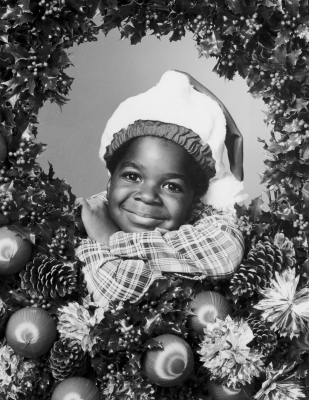
by Mark Masek
(supplementary information and snarkology by Scott)
Life can be pretty tough after you reach your professional peak at the age of 12. There’s only one direction to go from there. Gary Coleman proved it. In the final years of his life, the phrase “troubled former child star” almost became a required part of his name.
Even after his death in 2010 at the age of 42, he still can’t rest in peace.
Coleman was born on Feb. 8, 1968, in Zion, Ill., a small town north of Chicago near the Wisconsin border, to a homeless mother. He was adopted when he was four days old by Willy Coleman, a fork-lift operator for a pharmaceutical company, and his wife, Sue, a nurse practitioner.
Coleman was born with nephritis, a chronic and potentially fatal kidney disease which, when combined with the medications he took to treat it, limited his growth to 4-foot-8 and gave him a permanent, chubby-cheeked, childlike face, even into adulthood. Coleman underwent two unsuccessful kidney transplants, in 1973 and 1984, and required dialysis treatments throughout his life.
Cute, charming and talented, Coleman started appearing in television commercials at the age of 5, for companies including McDonald’s and Hallmark, and made his TV debut in an episode of “Medical Center” in 1974. A talent scout for producer Norman Lear spotted Coleman in a commercial for Chicago-based Harris Bank, and Lear brought Coleman and his parents to Los Angeles. Lear planned to produce a TV series remake of “The Little Rascals,” with Coleman starring as Stymie. A made-for-TV movie and three episodes of the series were filmed, but the series wasn’t picked up by any of the networks.
In early 1978, Coleman made guest appearances on Lear-produced series including “The Jeffersons,” “America 2-Night” and “Good Times.” Later that year, Lear cast 10-year-old Coleman in “Diff’rent Strokes,” as Arnold Jackson, one of two black brothers adopted by a wealthy white widower in Manhattan. In addition to Coleman, the cast included Conrad Bain as the wealthy widower, Philip Drummond; Todd Bridges as Coleman’s older brother, Willis; and Dana Plato as Drummond’s daughter, Kimberly.
“There was a touch of magic and a different stroke in Gary Coleman,” said Lear. “He was the inspiration behind his show’s title.”
The series debuted on NBC on Nov. 3, 1978, and finished the season No. 27 in the ratings. Although it was never a top 10 show, its highest season rating was No. 17 for 1980-81. “Diff’rent Strokes” was a solid, dependable sitcom hit for seven seasons on NBC. (When it moved to ABC for the 1985-86 season, it ranked 75th out of 85 shows, and was cancelled.)
“Diff’rent Strokes” is also remembered for a large number of “very special episodes,” which focused on issues including racism, bigotry, drug abuse, bullies, physical disabilities, kidnapping, junk food, pedophilia, child molestation, drunk driving, bed wetting and bulimia. But primarily, the show is remembered for making a star out of Gary Coleman, and later for the legal, financial and drug problems of its three young stars, the “Diff’rent Strokes” Curse.
Almost immediately, Coleman’s pint-sized confidence and wisecracking comedic skills made him the star of the show, and his “What choo talkin’ bout, Willis?” became a national catchphrase. Comedy legends Bob Hope and Lucille Ball praised the young comedy genius. Coleman was a frequent guest on “The Tonight Show,” trading quips with Johnny Carson.
From 1980 to 1983, Coleman won four consecutive People’s Choice Awards as Favorite Young TV Performer. (His streak was broken in 1984 by Emmanuel Lewis, who also won four times in a row.)
Coleman was a star. And he knew it.
After the first season of “Diff’rent Strokes,” Coleman held up shooting of the series because he wanted a pay raise from $1,500 to $30,000 per episode. He did it again in 1981, until they started filming the series without him. By 1982, 14-year-old Coleman was making $50,000 per episode, $1.3 million for the 26-show season, compared to $25,000 for Conrad Bain and $15,000 for Todd Bridges. Before the series ended, Coleman was making $80,000 per episode, and had earned a total of more than $7 million. He received an additional $1 million per year when the series went into syndication.
Include the handful of forgettable TV movies Coleman starred in between filming of the series, “Scout’s Honor,” “The Kid with the Broken Halo,” “The Kid with the 200 I.Q.,” “The Fantastic World of D.C. Collins” and “Playing with Fire“, and Coleman had reportedly earned a total of $18 million by the time he was 18.
“By 1981, I got tired of the doing the show,” Coleman said. “I didn’t wanna do it anymore. But there was nothing I could do about that, because the contract was already signed. So, I was a little bitter about that because I didn’t wanna be there. The character wasn’t growing up, and he wasn’t interesting to me anymore.”
With Coleman as the acknowledged star, and receiving the star-level paycheck and attention, there was growing jealousy on the set, particularly from Bain and Bridges.
When “Diff’rent Strokes” was cancelled in 1986, “I was enormously thrilled and was very much looking forward to starting the rest of my life,” Coleman said. “I want to escape that legacy of Arnold Jackson. I’m someone more. It would be nice if the world thought of me as something more.”
But first, Coleman wanted all that money he had earned.
Under California law, the vast majority of money earned by child performers is required to be placed in a protected bank account or trust fund. (The law went into effect in the late 1930s after Jackie Coogan, the youngest self-made millionaire in history, turned 21 and discovered that his mother and stepfather had spent nearly all of the $4 million he had earned during his career. Today, those protected bank accounts for child performers are called “Coogan accounts.”)
While Coleman was earning the huge paychecks on “Diff’rent Strokes,” his parents set up a trust fund, as required by law. But they also set themselves up as paid employees, receiving 20 percent of their son’s income. Lawyers, accountants, publicists and agents were hired. The group invested a large chunk of Coleman’s money in a Beverly Hills business, which went bankrupt. When Coleman turned 18 and the trust was dissolved, he discovered that there was less than $1 million in the account, $220,000 for Coleman and $770,000 for his parents.
In 1989, Coleman sued his parents and his business manager for squandering his fortune, and was awarded $1.28 million. But all of the money was soon spent on taxes, legal fees and medical bills for his continuing dialysis treatments. And Coleman never saw or spoke to his parents again.
Meanwhile, Coleman’s acting career after “Diff’rent Strokes” was limited to guest appearances on a few TV series, often in self-mocking roles. “I parody myself every chance I get,” Coleman said. “I try to make fun of myself and let people know that I’m a human being, and these things that have happened to me are real. I’m not just some cartoon who exists and suddenly doesn’t exist.”
But there didn’t seem to be a place for a child star who was no longer a child, even though he still looked like one. To make ends meet, Coleman found work as a security guard on a film set, using his middle name “Wayne” on his uniform name tag. In 1999, Coleman filed for bankruptcy.
(On the death of “Diff`rent Strokes” co-star Dana Plato) “It’s very unfortunate that Dana is no longer with us – she was a wonderful woman, but her death was a welcome, though sad piece of closure to “Diff’rent Strokes”. The possibility of a reunion no longer exists now, and thank God.”)
As long as the press is going to force, you know, “the Diff’rent Strokes curse”, the kids are cursed, I am never going to work. That’s always been unfair and unwarranted. Conrad Bane is not in jail. Charlotte Rae has not robbed a bank. There is no curse.
Gary tried his hand at phone sex. Some say this was done as a joke. I pray it wasn’t.
I’m small… but I know how to CHOO CHOO!
In 2003, Coleman ran for governor of California in the vote to recall Gov. Gray Davis, one of 135 candidates who qualified for the ballot. Coleman’s $3,500 filing fee was paid by a San Francisco Bay area newspaper. Arnold Schwarzenegger won the election to replace Davis, but Coleman finished a respectable eighth in the voting, just behind Hustler magazine publisher Larry Flynt, but ahead of porn star Mary Carey, comedian Gallagher and Los Angeles icon Angelyne.
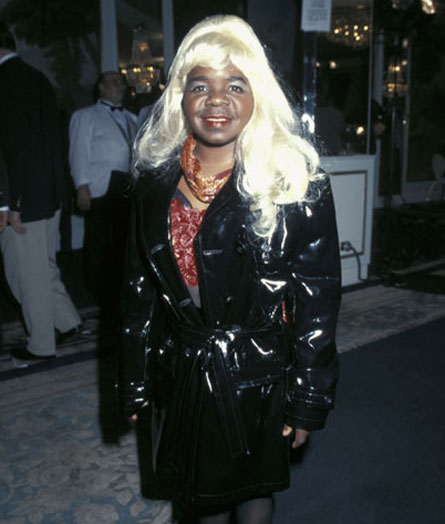
In addition to his health, financial and career problems, Coleman had more than a few brushes with the law. He was arrested in 1999 and charged with assault after he punched a persistent female fan in a shopping mall. Coleman pleaded no contest, received a suspended sentence, was ordered to pay the woman’s $1,665 hospital bill, and ordered to take anger-management classes.
“Imagine having major health problems,” Todd Bridges said about his former co-star after Coleman’s death. “Imagine getting ripped off of all your money. Imagine being raised in a household where he wasn’t taught how to love himself or to love others around him. So when he hit the world at an adult age, he wasn’t prepared.”
In 2005, Coleman moved to Santaquin, Utah, a small town south of Provo. While he was filming “Church Ball” in Utah, Coleman met actress Shannon Price. Five months later, she proposed, and they were married on a mountaintop in Valley of the Fire State Park in Nevada on Aug. 28, 2007, the bride’s 22nd birthday. The groom was 39.
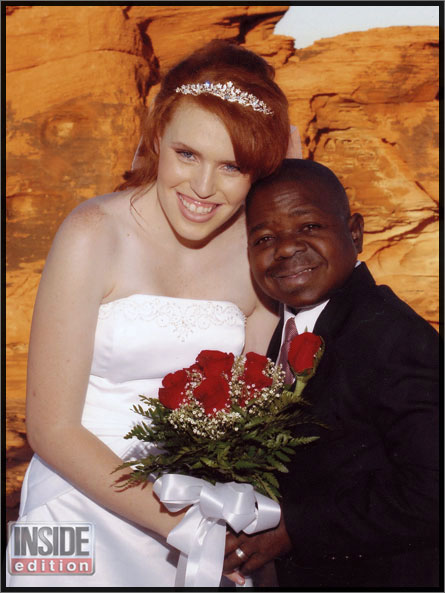
They holed up in this attractive home with spectacular views.


It seems that his wife was a Scentsy dealer. There’s product placement for you.

Death Hag Chris Mortenson snapped these home photographs and some pretty amazing amount of garbage dumped around it. What I wouldn’t do for some Gary Coleman Wasp Killer.


It was around this time that I met Gary in Los Angeles. I was working as a tour guide for that big Hollywood tour company. I took Ryan Seacrest around for his TV show.
I opened the door for Coleman, who entered the bus sneezing and congested. He walked past me without a greeting (button pushed), and absently handed me a balled-up-snot-filled Kleenex, to which I responded with, “I’m not touching that shit.” The people on the bus loved him. He made several statements like, “Now you’re going to be famous.” “After this show you’ll be famous.” “Everybody comes here to be famous.”
People enjoyed him and he sopped it up.
His nasty reputation is legendary. It’s terrible that millions of dollars were stolen from him, however I don’t think we should have to process that to excuse his poor behavior.
Shortly after he was married, Coleman was arrested for disorderly conduct in Provo after a heated discussion in public with his wife. The following year, Coleman got into an argument with a photographer in this parking lot of a bowling alley in Payson, Utah.

Coleman then got into his truck and backed into the man, knocking him down. Coleman was charged with disorderly conduct and reckless driving, again pleaded no contest, and was fined $100.
How would you like to turn on your bedside lamp and see this face staring at you from across the room?
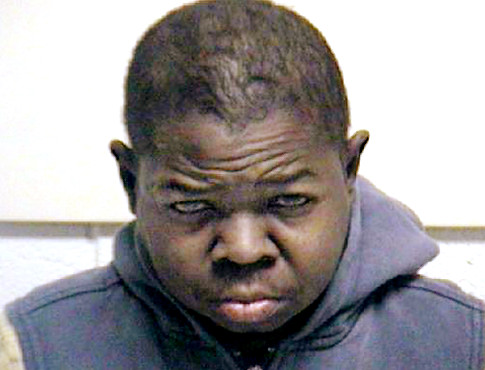
pretttttty gary…
On May 1 and 2, 2008, Coleman returned to television with his wife, but this time they were appearing on “Divorce Court,” to air their differences in an attempt to save their marriage. Price said Coleman had anger issues: “If he doesn’t get his way, he throws a temper tantrum like a 5-year-old does. He stomps the floor and he starts throwing stuff around and he bashes his head in the wall, too.”
Despite their public efforts at reconciliation, Coleman and Price were divorced after less than a year after their marriage, on Aug. 12, 2008. But they continued to live together as husband and wife in Santaquin. And they continued to fight. In 2009, they were involved in another domestic dispute. Price was arrested on suspicion of domestic violence, and both parties were cited for disorderly conduct.
Along with the marital discord, Coleman’s health problems worsened. In early 2009, Coleman appeared in his final film, “Midgets vs. Mascots,” which was filmed in Dallas. Now, this movie I loved. It’s like a knock off of the Jackass movies. It’s revolting and hilarious. There was a bit of controversy over a Gary’s ding-dong shot. Gary got into a scuffle while wearing a robe and it opened. It was all planned for the cameras, but seeing him with a fake horse-like appendage was an eye opener.
Later that year, he underwent heart surgery to replace his aortic valve, then developed pneumonia. At the time, doctors said he had a year to live. In January 2010, he was hospitalized after suffering a seizure in Los Angeles, and he was hospitalized again the following month after suffering another seizure, on the set of “The Insider” TV series.
On May 26, 2010, Coleman was back with his ex-wife in their home in Santaquin when he “fell down a flight of stairs” and hit his head, possibly after another seizure, and suffered an intracranial hemorrhage, bleeding inside the skull. Price called 911, referring to Coleman as her “husband”. This call is sad – I feel for the little jerk when she says she can’t help him because she can’t handle the stress.
Vile.
Coleman was taken to Utah Valley Regional Medical Center in Provo.



When he arrived at the hospital, Coleman was described as “conscious and lucid,” but his condition had severely deteriorated by the following morning.
By the afternoon of May 27, Coleman was unconscious and was placed on life support.
The next day, Price made the decision to take him off life support, and Coleman died on May 28, at 12:05 p.m.
“The doctors advised me that he wasn’t going to make it,” Price said. “His heart was giving out. It was the most difficult decision I’ve ever had to make in my entire life”. Seeing Gary in that circumstance, it was best for him to go and not suffer. He was already a vegetable.”
“I don’t want people to be so hard on me thinking that I had to pull the plug too early,” Price said. “He wouldn’t have made it anyway. His heart would have just given out. I mean, Gary was gone. His eyes were dilated. He wasn’t… he was just gone.”
During his final days, Price posed for a photograph in the hospital with the comatose former child star. The photo later appeared on the cover of the Globe tabloid, with the headline: “Gary Coleman: It was murder! – Wife Shannon sobs: I didn’t push him.” The tabloid acknowledged that it purchased the photo, but didn’t say who sold it, or the price. I’m sure it was that beastly woman.
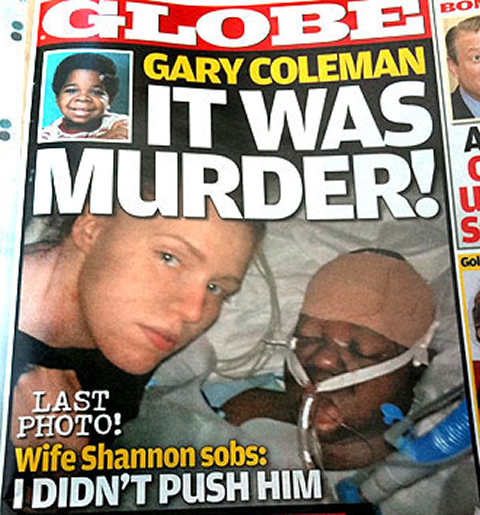
Price never contacted Coleman’s parents.
“We would’ve loved to have been there by his side at the hospital, to let him know we love him before he passed away,” Sue Coleman said. “This is a shock to us. We loved Gary very much. We’re going to miss him.”
I’m sure they do mi$$ him. A lot.
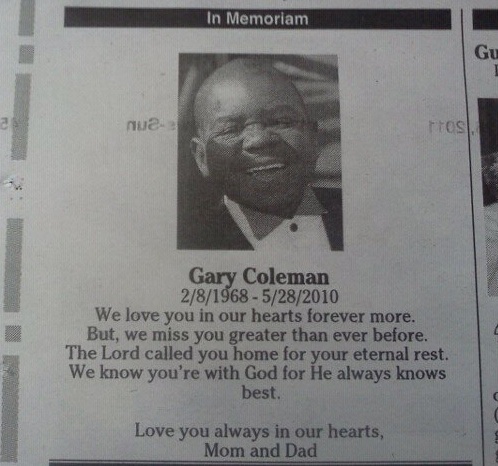
“We respect the relationship our $on had with Shannon,” Sue Coleman said. “When we found out he got married, we thought, well, at least he has someone in his life who he cares about and who cares about him. We were happy about that. But it’s frustrating that we haven’t heard from the Price family. But it’s possible they didn’t even know we existed. Gary may have told her that he didn’t have any family.”
Almost immediately after Coleman’s death, questions arose about the circumstances surrounding the fall, and questions about whether Price, his ex-wife, had the legal authority to order the life support to be turned off.
The hospital issued a statement confirming that Coleman has completed an Advanced Health Care Directive, granting Price permission to make medical decisions on his behalf, although the document directed that he be kept alive for at least 15 days. An investigation by Santaquin police was closed on Oct. 5, 2010, and the medical examiner ruled that Coleman’s death was “accidental.”
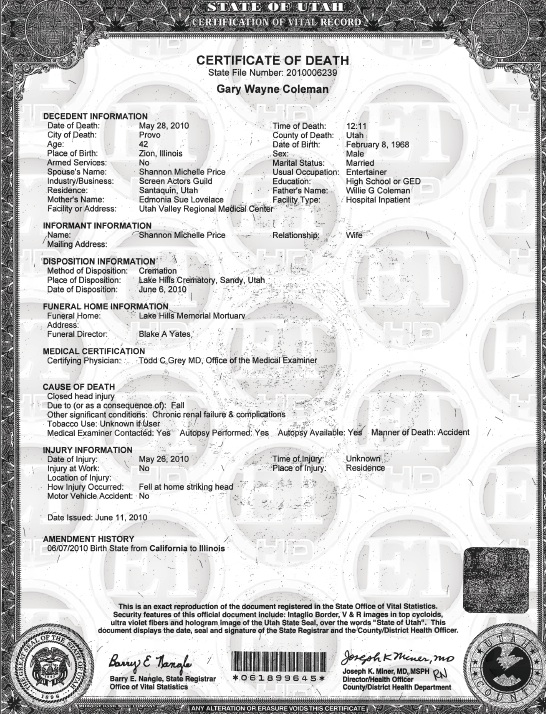
Thanks Paul Blum
“There was absolutely nothing suspicious about (Coleman’s) death,” said Santaquin Police Chief Dennis Howard. “There is no investigation going on.”
Even after death, Coleman could not rest in peace. A funeral service was scheduled for the weekend after his death, but was postponed, then cancelled after disputes arose between his ex-wife and his parents over the disposition of his estate and his final resting place.
A two-page will written by Coleman in 1999 was filed with the court in June 2010. The document requests that his remains be cremated, and that his funeral service be attended only by “those who have no financial ties to me and who can look each other in the eyes and say they really cared personally for Gary Coleman. “I direct my personal representative to permit no members of the press to be present at my wake or funeral.” The 1999 will names Coleman’s former manager, Dion Mial, as executor of his estate.
A few days later, another will surfaced, this one written in 2005, in which Coleman leaves everything to Anna Gray. Coleman reportedly met Gray in 1997 and they lived together, in separate bedrooms, in his home in Los Angeles until 2005, when he met Price in Utah.
The 2005 will named Gray as executor, awarded his entire estate to her, and requested “that there be no funeral service, wake, or other ceremony memorializing my passing.” However, Price and Coleman were married in 2007. Although they divorced a year later, Price claimed in a court petition that she remained Coleman’s common-law wife, sharing bank accounts and presenting themselves publicly as husband and wife, until his death. (Utah is one of the few states that legally recognizes common-law marriage.)
Price then produced a will written by Coleman on Sept. 4, 2007, shortly after their marriage, in which he names her as his sole beneficiary. The hand-written document, however, wasn’t witnessed or notarized. Coleman’s parents have filed legal objections to Price being named the sole beneficiary, and to her official status as Coleman’s widow.
Meanwhile, Coleman’s body was cremated on June 17, 2010, after a Utah judge ruled that there was no dispute over his wishes on that issue, and his ashes were placed in storage at Lake Hill Mortuary in Sandy, Utah. Coleman’s parents, who have never met or spoken to Price, wanted to bring his remains back for burial in Zion, Ill. Price wants to scatter his ashes at the Golden Spike National Historic Site in Utah as a tribute to Coleman’s love of trains, and also to carry a tiny pinch of Coleman’s ashes in a locket around her neck.
And it’s not like Gray, Price and Coleman’s parents are fighting over a lot of money. In fact, Coleman’s primary asset was his house in Utah, worth an estimated $325,000. According to records, Coleman was upside-down on the mortgage, meaning he owed more than the house was worth when he died.
The probate judge appointed a special administrator to try to sort everything out. Until that happens, Coleman’s remains will continue to rest on a shelf in the administrator’s office.

Trivia: Coleman was obsessed with trains. A long-time Sheriff’s Department member sends me this, “A buddy of mine, a Sheriff, busted Gary Coleman jerking off at some train tracks. It’s a subculture of people called “Foamers” who are sexually aroused by trains. He was pretty shocked to find Gary Coleman way down in Whittier. He let him go.
I went to a train store in Pasadena once and the guy there mentioned how Gary Coleman had just died…and everyone in the store knew him as a frequent customer.
HAHAHAHAHA
Mark Langlois sent me a link to a People Magazine article from 1991 that includes the quote, “Tabloid citings since last fall include reports that Coleman legally changed his name to Andy Shane and asked a former female housemate if he could suck her toes. His parents don’t know if any of that is true, but W.G. says. “All indications lead me to believe that Gary’s totally out of sync with the world.”
Molly Shannon told Conan a very funny story about her experience with Gary. If you do nothing else this week, watch this video. Seriously.
Oh wait! Wanna see his mailbox?

Thank you to Chris Mortensen for the amazing photographs in UT.
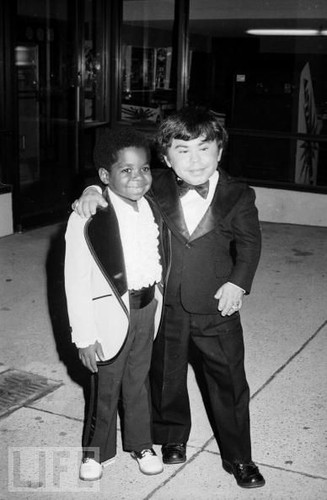
Rock ‘n’ Roll

Googled it and the judge ruled the handwritten will for price invalid and gray was the beneficiary since that was the last valid will.
Trains?!
Saw him at the now closed Westside Pavillion shopping Center in West LA. Taking the rooftop escalator down, saw him taking the groundfloor escalator up. Shocked how normal he appeared. Really thought with all the baggage reported about, and from him, would “radiate” anger and hostility in person. (Hello Jack Carter) Was all alone with a big happy smile on his face. RIP Arnold